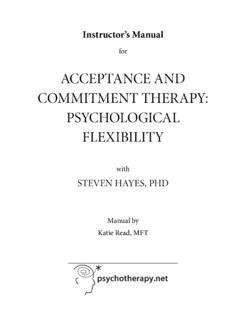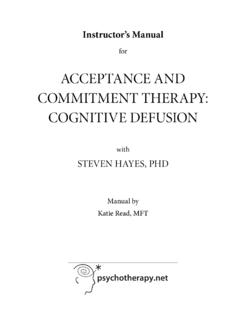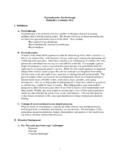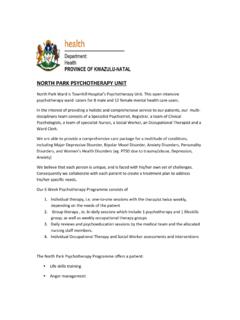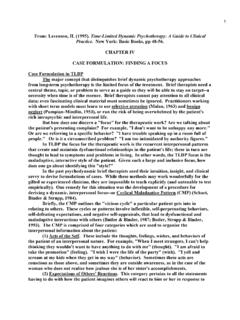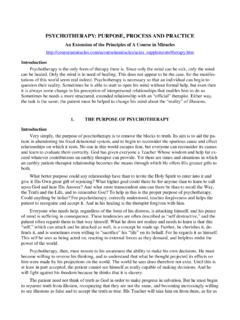Transcription of CLINICAL INTERVIEWING: INTAKE ... - …
1 Instructor s ManualforCLINICAL interviewing : INTAKE , ASSESSMENT, AND THERAPEUTIC ALLIANCE withJOHN SOMMERS-FLANAGANAND RITA SOMMERS-FLANAGANM anual byShirin Shoai, MA2 CLINICAL interviewing : INTAKE , ASSESSMENT, AND THERAPEUTIC ALLIANCE! e CLINICAL interviewing : INTAKE , Assessment, and ! erapeutic Alliance with John Sommers-Flanagan and Rita Sommers-Flanagan (Institutional/Instructor s Version). Video available at 2014, , LLC. All rights reserved. Published by Shoreline Highway, Building A, Suite 1 Mill Valley, CA 94941 Email: (800) 577-4762 (US & Canada)/(415) 332-3232 Teaching and Training: Instructors, training directors and facilitators using the Instructor s Manual for the video CLINICAL interviewing : INTAKE , Assessment, and ! erapeutic Alliance with John Sommers-Flanagan and Rita Sommers-Flanagan may reproduce parts of this manual in paper form for teaching and training purposes only.
2 Otherwise, the text of this publication may not be reproduced, stored in a retrieval system, or transmitted in any form or by any means electronic, mechanical, photocopying, recording or otherwise without the prior written permission of the publisher, ! e video CLINICAL interviewing : INTAKE , Assessment, and ! erapeutic Alliance with John Sommers-Flanagan and Rita Sommers-Flanagan (Institutional/Instructor s Version) is licensed for group training and teaching purposes. Broadcasting or transmission of this video via satellite, Internet, video conferencing, streaming, distance learning courses or other means is prohibited without the prior written permission of the Shoai, MAClinical interviewing : INTAKE , Assessment, and ! erapeutic Alliance with John Sommers-Flanagan and Rita Sommers-FlanaganCover design by Julie GilesOrder Information and Continuing Education Credits:For information on ordering and obtaining continuing education credits for this and other psychotherapy training videos, please visit us or call s Manual forCLINICAL interviewing : INTAKE , ASSESSMENT, AND THERAPEUTIC ALLIANCEWITH JOHN SOMMERS"FLANAGANAND RITA SOMMERS"FLANAGANT able of ContentsTips for Making the Best Use of the Video 4!
3 E Sommers-Flanagans Approach to CLINICAL interviewing 6 Basic Listening Skills: Summary, Discussion Questions, Role-Plays 8 Directive Listening Responses: Summary, Discussion Questions, Role-Plays 13 Directives & Action Responses: Summary, Discussion Questions, Role-Plays 17 Questions & ! erapeutic Questions: Summary, Discussion Questions, Role-Plays 21 INTAKE Interview: Summary, Discussion Questions, Role-Plays 26 Mental Status Examination: Summary, Discussion Questions, Role-Plays 31 Suicide Assessment Interview: Summary, Discussion Questions, Role-Plays 36 Reaction Paper Guide for Classrooms and Training 41 Related Websites, Videos and Further Readings 42 Tra nscript 43 Video Credits 101 Earn Continuing Education Credits for Watching Videos 102 About the Contributors 103 More Videos 1044 CLINICAL interviewing : INTAKE , ASSESSMENT, AND THERAPEUTIC ALLIANCETips for Making the Best Use of the Video1.
4 USE THE TRANSCRIPTS Make notes in the video Tra nscript for future reference; the next time you show the video you will have them available. Highlight or notate key moments in the video to better facilitate discussion during and a# er the FACILITATE DISCUSSION Pause the video at di$ erent points to elicit viewers observations and reactions to the concepts presented. ! e Discussion Questions sections provide ideas about key points that can stimulate rich discussions and learning. 3. ENCOURAGE SHARING OF OPINIONSE ncourage viewers to voice their opinions. What are viewers impressions of what is presented in the interviews? 4. CONDUCT A ROLE-PLAY! e Role-Play sections guide you through exercises you can assign to your students in the classroom or training SUGGEST READINGS TO ENRICH VIDEO MATERIALA ssign readings from Related Websites, Videos and Further Reading prior to or a# er ASSIGN A REACTION PAPERSee suggestions in the Reaction Paper ON VIDEOS AND THE PERSONALITY OF THE CLINICIANP sychotherapy portrayed in videos is less o$ -the-cu$ than therapy in practice.
5 Clinicians may feel put on the spot to o$ er a good demonstration, and clients can be self-conscious in front of a camera. Clinicians o# en move more quickly than they would in everyday practice to demonstrate a particular technique. Despite these factors, counselors and clients on video can engage in a realistic session that conveys a wealth of information not contained in books or therapy transcripts: body language, tone of voice, facial expression, rhythm of the interaction, quality of the alliance all aspects of the therapeutic relationship that are unique to an interpersonal encounter. psychotherapy is an intensely private matter. Unlike the training in other professions, students and practitioners rarely have an opportunity to see their mentors at work. But watching therapy on video is the next best more note: ! e personal style of counselors is o# en as important as their techniques and theories.
6 Counselors are usually drawn to approaches that mesh well with their own personality. ! us, while we can certainly pick up ideas from master clinicians, students and trainees must make the best use of relevant theory, technique and research that % ts their own personal style and the needs of their AND CONFIDENTIALITY Because this video contains actual counseling sessions, please take care to protect the privacy and con% dentiality of the clients who have courageously shared their personal lives with us. 6 CLINICAL interviewing : INTAKE , ASSESSMENT, AND THERAPEUTIC ALLIANCE! e Sommers-Flanagans Approachto CLINICAL interviewing *! e CLINICAL interview has been referred to as the foundation of all mental health treatment and as arguably the most valuable skill among psychologists and other mental health practitioners. Professionals from several di$ erent disciplines ( , psychologists, psychiatrists, counselors, and social workers) utilize CLINICAL interviewing procedures.
7 Although de% ned di$ erently by di$ erent authors, the CLINICAL interview includes an informed consent process and has as its primary goals (a) initiation of a therapeutic alliance; (b) assessment or diagnostic data collection; (c) case formulation; and/or (d) implementation of a psychological CLINICAL interviews implicitly address the % rst two primary goals ( , relationship development and assessment or evaluation), while some also include a case formulation or psychological intervention. Using the Sommers-Flanagan approach, it is possible to simultaneously address all of these goals in a single CLINICAL interview. For example, in a crisis situation, a mental health professional might conduct a CLINICAL interview designed to quickly establish rapport or an alliance, gather assessment data, formulate and discuss an initial treatment plan, and implement an intervention or make a referral.
8 Overall, the quality and quantity of information gathered and the intervention applied depends almost entirely on the interview s purpose and the clinician s theoretical orientation. For example, if the interview s purpose is to establish a working psychiatric diagnosis, the clinician will be asking speci% c questions about patient symptoms. In contrast, if the purpose of the interview is to establish rapport and initiate a working alliance, then the interviewer is likely to use more nondirective listening skills designed to show empathic understanding of the patient s situation, concerns, and this video, John and Rita Sommers-Flanagan guide clinicians through more basic listening skills onward to more advanced, complex interviewing activities such as INTAKE interviewing , mental status examinations, and suicide assessment. For beginning clinicians or those with more substantial experience, this video presents a systematic of the skills needed for conducting competent and professional CLINICAL interviews.
9 *Adapted from Sommers-Flanagan, J., Zeleke, W., & Hood, M. E. (2014, in press). ! e CLINICAL interview. In R. Cautin and S. Lilienfeld (Eds). ! e encyclopedia of CLINICAL psychology (page numbers unknown). London: , J. and Sommers-Flanagan, R. (2014). CLINICAL interviewing , Fi# h interviewing : INTAKE , ASSESSMENT, AND THERAPEUTIC ALLIANCEB asic Listening Skills SUMMARYB asic listening skills, according to the Sommers-Flanagans, are part of a wider continuum of CLINICAL interviewing behaviors (or listening responses ) that serve to establish a therapeutic alliance, glean diagnostic information, set the basis for a treatment plan, and act as a relational background for therapeutic interventions. ! is continuum ranges from less directive, or nondirective, listening behaviors to more active-directive, complex ones that aim to guide the client toward a speci% c therapeutic listening responses include: Attending behaviors (drawn from clinician Alan Ivey): eye contact body posture voice tone verbal tracking Other behaviors presented by the Sommers-Flanagans: silence clari% cations (verbal prompt) paraphrasing re& ection of feeling summarizationIt is important to note that these behaviors do not represent a static, linear set of interventions, but rather can be modi% ed and tailored to your client, in your own voice.
10 John Sommers-Flanagan emphasizes the role of therapist authenticity in a client s feeling heard; indeed the very act of listening, he says, is a gi# that clients will resonate with if o$ ered from a place of awareness. It is also imperative for therapists to understand the various factors cultural, personality-based, etc. that may be either implicitly or explicitly impacting a client s experience. Some clients, for instance, may balk at too much eye contact or questioning, while others may feel less of a therapist who asks fewer questions. ! e power di$ erential between therapist and client, furthermore, may mean that a clinician may be perceived as directive even when he or she isn t intending to be. ! e Sommers-Flanagans stress the need for therapists to % nd a balance between their natural tone and one that takes into account the particular qualities of each client.! at said, they also maintain that basic listening is a skill set that can be learned and will improve with time and practice.
